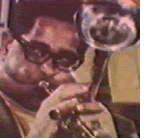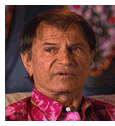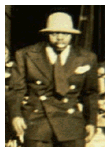 RealAudio clips require RealAudio Player
version 2.0 or higher. Click here
to download a new version.
RealAudio clips require RealAudio Player
version 2.0 or higher. Click here
to download a new version. |
 |
 |
 |


|
 |
 Dizzy Gillespie's trademark bent horn wasn't always that way. In 1953, Dizzy was performing at Snookie's, a now-defunct club at the corner of 47th and Broadway.
No two people have the same story about what happened. Dizzy Gillespie's trademark bent horn wasn't always that way. In 1953, Dizzy was performing at Snookie's, a now-defunct club at the corner of 47th and Broadway.
No two people have the same story about what happened.
Listen here to Harold "Stumpy" Cromer and my mother, Norma Storch, who was at that time living with my father, James "Stump" Cross, give their versions.
Read the Real Audio transcript.
|
|
And click here to read Dizzy Gillespie and James "Stump" Cross tell their version of the story to Al Fraser, Dizzy Gillespie's biographer, in his book, "To
Be or Not to Bop".
Footnote:
After hearing all these stories and noticing that Copesetics' member LeRoy Meyers was also there that night, I called him and asked for his version. "Harold wasn't even there." he says. "I was on the stage with Stump, doing the act, and I pushed him an
d he fell down and the horn bent. That's how it happened." LeRoy doesn't remember my mother Norma being there either. I guess it's all in the eye of the beholder. (June Cross)
|
 |


|

|
 |


|
 |
 LeRoy Meyers and Buster Brown are members of the Copesetics Tap Dancers. The Copesetics are a society of tap dancers founded in honor of Bill "Bojangles" Robinson
- who used the term "copesetic" the same way we say "everything's alright!" LeRoy Meyers, who once worked as road manger for The Supremes and BB King, is a comedian and dancer in his own right. They describe what it was like back in th
e days when there was black show business and white show business, and unequal opportunity between the two. LeRoy Meyers and Buster Brown are members of the Copesetics Tap Dancers. The Copesetics are a society of tap dancers founded in honor of Bill "Bojangles" Robinson
- who used the term "copesetic" the same way we say "everything's alright!" LeRoy Meyers, who once worked as road manger for The Supremes and BB King, is a comedian and dancer in his own right. They describe what it was like back in th
e days when there was black show business and white show business, and unequal opportunity between the two.  After their stories, Lois Basden, one of the women in Jimmy Cross'
life, tells another about how that inequality played out in the case of Martin and Lewis and Stump and Stumpy. After their stories, Lois Basden, one of the women in Jimmy Cross'
life, tells another about how that inequality played out in the case of Martin and Lewis and Stump and Stumpy.
Read the Real Audio transcript.
|
 |
 Jerry Lewis is one of the few comedians who survived and prospered as show
business moved from a stage and theatre-oriented business to one anchored
and fed by television. Here, Lewis tells his own stories about how black and white entertainers got around segregation in the days when even being seen
together violated the norm. Jerry Lewis is one of the few comedians who survived and prospered as show
business moved from a stage and theatre-oriented business to one anchored
and fed by television. Here, Lewis tells his own stories about how black and white entertainers got around segregation in the days when even being seen
together violated the norm.
Read the Real Audio transcript. |
 |


|
|
 |


|
 |
 Here, Larry Storch remembers how blacks and whites performed mostly in
separate theaters. Those few blacks who did "crossover" to white entertainment
houses were expected to do a pat routine: a little singing, a little dancing, and
off - a warmup for the main act - usually comedy in those days. The Will Maston
trio, which featured young Sammy Davis Jr., was one of those crossover acts.
When Sammy Davis, Jr. asked Storch to teach him some "voices", he took a
risk.
Here, Larry Storch remembers how blacks and whites performed mostly in
separate theaters. Those few blacks who did "crossover" to white entertainment
houses were expected to do a pat routine: a little singing, a little dancing, and
off - a warmup for the main act - usually comedy in those days. The Will Maston
trio, which featured young Sammy Davis Jr., was one of those crossover acts.
When Sammy Davis, Jr. asked Storch to teach him some "voices", he took a
risk.

Stump (Jimmy Cross) and Stumpy were stars in the black circuit, but their
careers remained limited because their act mixed dancing, singing,
impersonations, and comedy - but there was little room for that kind of act in
front of white audiences. Comedy was where the big money was. Jimmy's
horizons were limited from the jump.
Read the Real Audio transcript. |
 |
"I Ain't Got Nobody" was Jimmy's trademark song. It was first done by the vaudevillian Bert Williams in the early 1900s...(and most recently covered in the late eighties in a 1985 rock n' roll version by David Lee Roth. "Jimmy had great
respect for the tradition of black theater," Lois Basden remembers.  "He did this highly exaggerated "I Ain't Got Nobody". And people would laugh till the tears came down t
heir faces. I'd cry, because deep in the depths of James Cross, there was that feeling of loneliness." The song was originally a ballad, LeRoy Meyers and Buster Brown, members of the Copesetics Tap Dancers, remember that Jimmy did a version of it that song that broke up the house - with laughter. It exemplified Jimmy's whole act, Buster says. "He did this highly exaggerated "I Ain't Got Nobody". And people would laugh till the tears came down t
heir faces. I'd cry, because deep in the depths of James Cross, there was that feeling of loneliness." The song was originally a ballad, LeRoy Meyers and Buster Brown, members of the Copesetics Tap Dancers, remember that Jimmy did a version of it that song that broke up the house - with laughter. It exemplified Jimmy's whole act, Buster says.
Read the Real Audio transcript. |
|